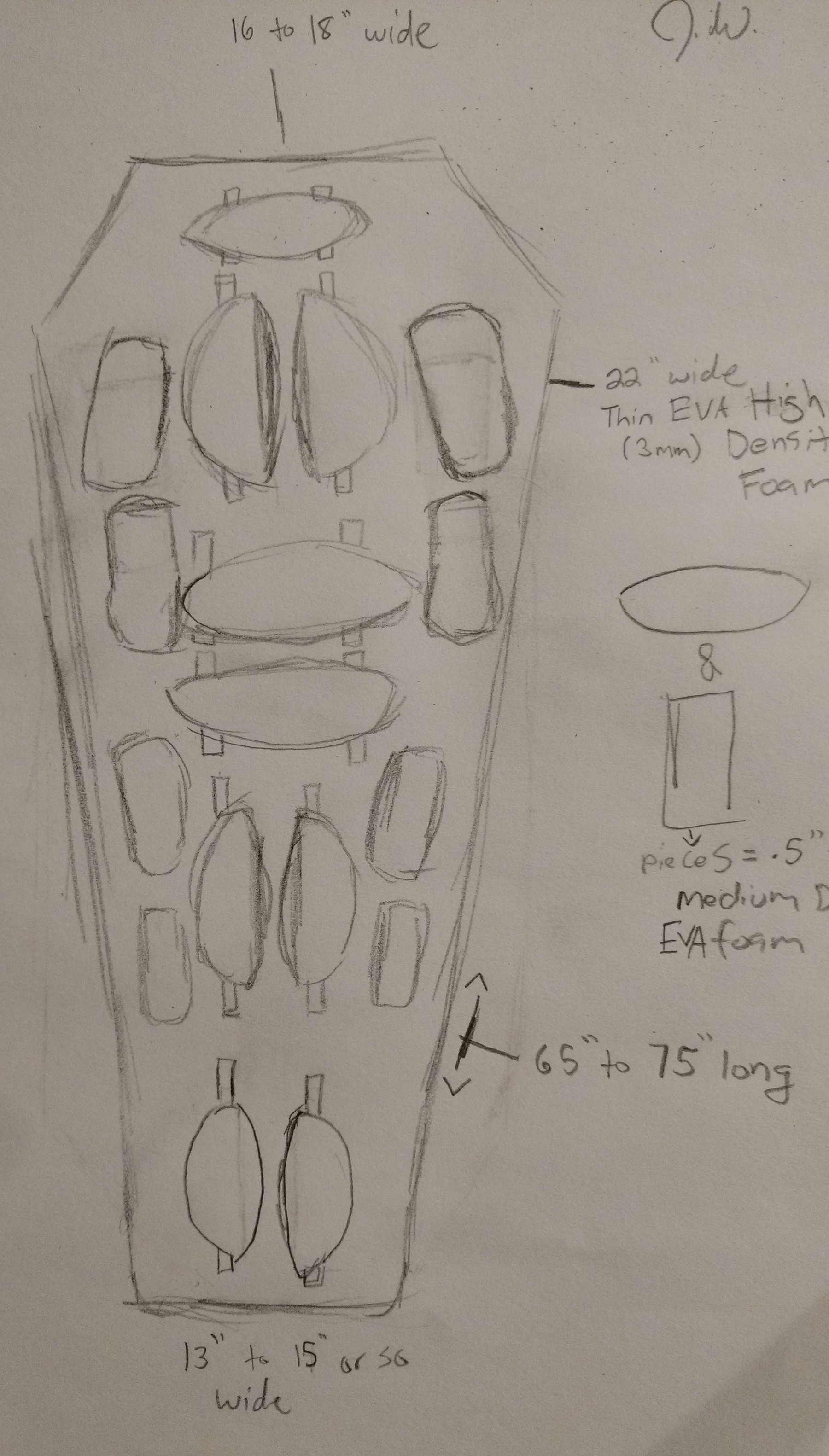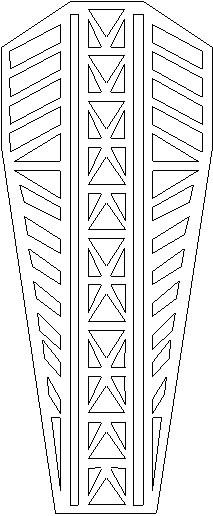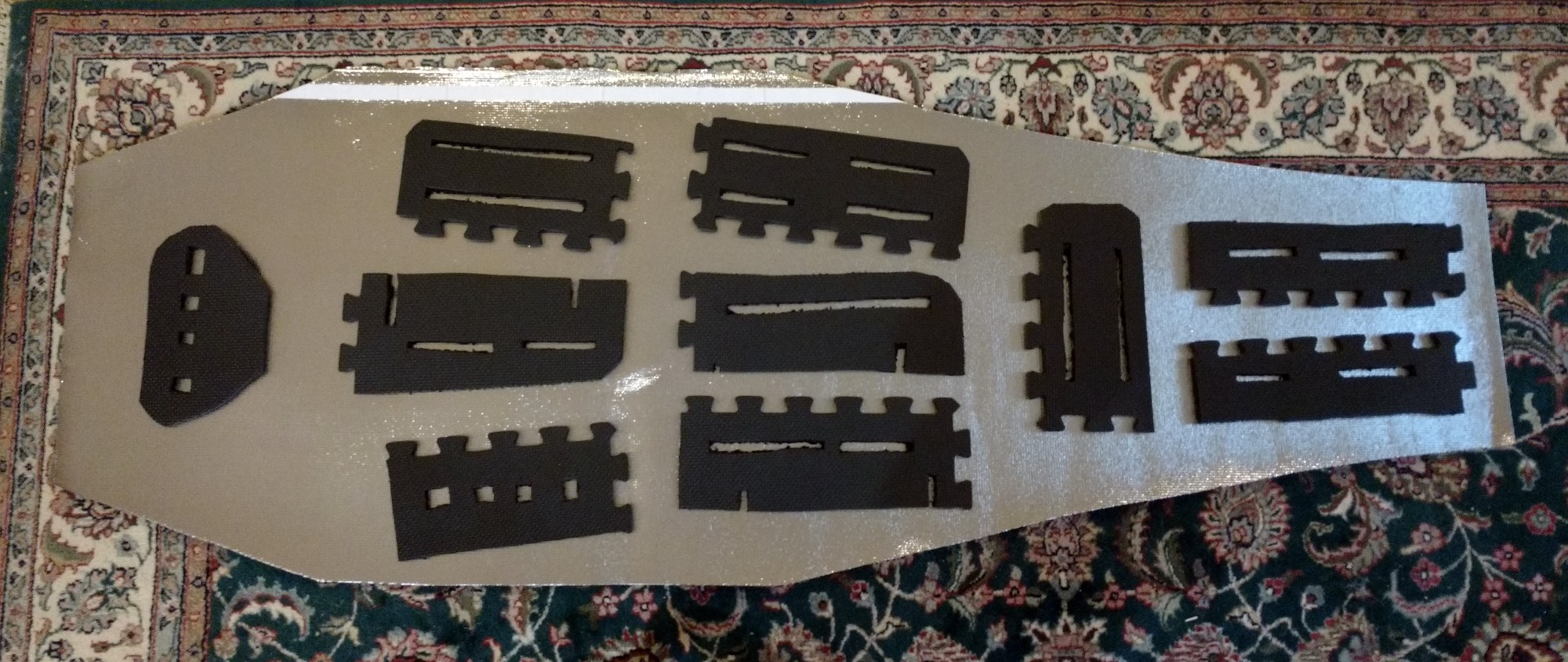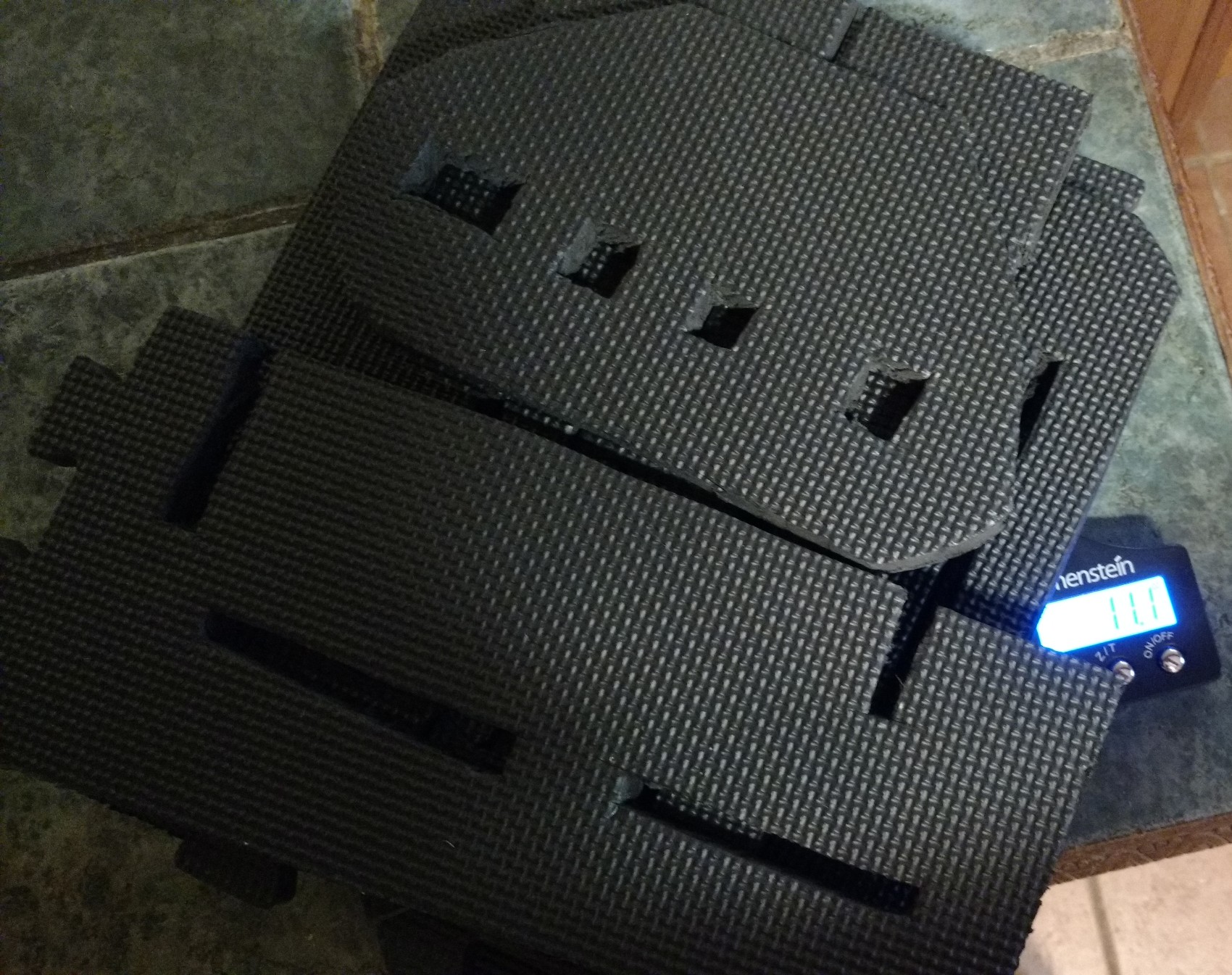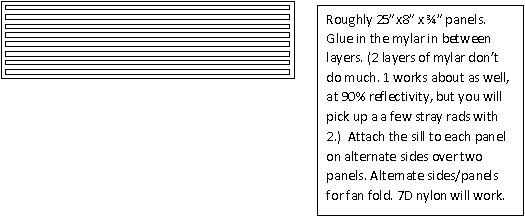Topic
World's most comfortable, lightest, warmest, and adaptable CCF pad?
Forum Posting
A Membership is required to post in the forums. Login or become a member to post in the member forums!
Home › Forums › Gear Forums › Make Your Own Gear › World's most comfortable, lightest, warmest, and adaptable CCF pad?
- This topic has 49 replies, 7 voices, and was last updated 5 years, 8 months ago by
Anonymous.
-
AuthorPosts
-
May 27, 2019 at 5:11 am #3594892
Anonymous
Inactive… N.E. post
May 27, 2019 at 5:46 am #3594894Anonymous
InactiveThis is a very rough draft concept. At some point, I’m going to have my spouse, who is a shade under 5′ 10″ lay down on a foam pad, and I’m going to map out highest pressure areas of hips, knees, shoulders, etc. If I can, I will pare it down to fewer and/or smaller pieces of connecting foam pieces than in the drawing below.
An intro into the concept and why the design:
EVA based CCF foam has some definite advantages and disadvantages.
Advantages include high insulation capacity per low weight, pretty durable, fairly inexpensive, provides some cushion/comfort, highly reliable (vs air pads), more hygienic/sanitary than air pads (especially if blowing them by your breath).
Disadvantages include bulky/high volume in general and especially vs air pads and doesn’t provide near as much cushion/comfort as air pads. Not particularly eco friendly, but when you consider it’s longevity over air pads, it balances out some long term.Designer wondered, could one increase comfort of CCF pad enough to use only foam and not have to bring an air pad? How could one minimize weight and bulk and boost insulation while doing so? How could one make a pad comfortable and adjustable for various different body types and sizes vs a one size or near one size fits all?
Picture of drawing, and will explain concept in more detail.

Didn’t write it in, but those thin, rectangular strips you see in the above, are pieces of soft velcro bonded onto the thin foam. The .5″ thick medium density “comfort zone” pieces of foam have corresponding hard velcro bonded onto to them. Generally the strips of soft velcro on thin foam/main structure are longer so that one can move them up and down depending on height and specific body features.
Not mentioned on the pic, is that the thin foam has a layer of reflective IR material on top. The cushion pieces do a few things simultaneously. They create enough cushion to improve comfort, they create enough of an air gap that IR reflective exposed parts will reflect that heat back up, and if you use a sleeping bag with this system, you’ll get extra insulation at less pad weight for those gapped areas, similar to Kylmit’s “loft pockets” concept.
Further more, a UL fabric sleeve, with a UL WP bottom and tightly woven/low CFM UL top fabric would accompany the pad to keep same clean, especially the velcro. Instead of subjecting the pad constantly to body oils, dirt, etc, you subject the fabric sleeve to same and that can be washed easily. Also, it should help to boost insulation slightly (slowing down convective currents in the gapped areas some, especially if you only use quilts).
The thin foam pad will roll up pretty thin, and can be rolled up within the fabric sleeve, with the WP part facing out since that would handle potential outside abrasion, scratches, etc better if put on the outside. However, it’s thin and small enough, you could potentially put it on the inside also.
Now, the .5″ cushion EVA foam piece are pretty thick in comparison and would take up too much space within a pack, but put them in a silnylon sack, and tie it onto the outside of one’s pack. It would be very light weight, so it won’t imbalance anything. You could also use a couple pieces or so, for strategic cushioning within the pack if you have some room and want the extra cushioning.
Some of the larger pieces will have some extra, soft velcro on them, so that they can be stacked upon one another for an extra higher and cushy sit pad.
What’s the point of such a pad? Especially for people that do serious cold trips who don’t want to deal with the faff and potential field failure of air pads, BUT who at the same time, don’t find commercially available CCF pads comfortable enough to use alone. People like myself fit into that category.
Or say, you just want a highly, highly durable, long lasting pad that won’t break the bank. Say a consistently priced 60 to 75 dollar pad that won’t ever fail. Something that is light weight and very warm for the weight, especially when you combine it with a sleeping bag. (And in serious cold, I combine a very light sleeping bag, with a thicker quilt).
But say it’s summer and warm’ish weather, and you already have a UL air pad (like an un-insulated Klymit pad) and aren’t needing much insulation or extra cushion. Just take the thin foam part with you to combine with the lightweight air pad, for a bit of insulation boost and air pad protection. Put both in the fabric sleeve to stabilize and keep clean both, or use the fabric sleeve as impromptu bivy, by leaving these out of the fabric sleeve and putting just you and your quilt/bag in the fabric sleeve, on top of the thin foam pad/air pad combo.
Whole point is that is meant to be a very adaptable and adjustable system, depending on season/conditions, body type, etc but always dependable/reliable, durable, light weight.
I plan to eventually market and sell these, along with some other unique items.
May 27, 2019 at 7:23 am #3594895more hygienic/sanitary than air pads (especially if blowing them by your breath).
Well, smart people these days use a pump of some sort to avoid the condensation issue.Otherwise, I am not aware of ANY sanitary issues with air mats. The smooth surface is probably LESS likely to pick up contaminants than CCF. And yes, we use both: 1/8″ Evazote under an Exped Synmat UL7.
I plan to eventually market and sell these,
You will have to get them made in Asia if you want the price to be at all competitive. They will probably want an order for at least several hundred. Big $ gamble.May 27, 2019 at 11:42 am #3594900Actually the “Body Mapping” has been around for a while. Klymit does this with the XFrame. https://www.klymit.com/technology
However, I have wondered in the past about a more comfortable pad. Everything I came up with is either very bulkey and/or heavy. For instance, you can take 1/8″ foam and layer them over a center of 1/4″ foam cutouts. Total thickness will be around 1/2″ but a lot lighter with good insulating value. You can even add a thermal blanket between them.
 May 27, 2019 at 5:35 pm #3594952
May 27, 2019 at 5:35 pm #3594952Anonymous
Inactive“Well, smart people these days use a pump of some sort to avoid the condensation issue.”
That is the ideal, best practice, but I strongly wonder just how many people actually only ever use pumps to blow up their air pads? Probably a higher percentage of folks at BPL than many other places, but population at large?
“Otherwise, I am not aware of ANY sanitary issues with air mats. The smooth surface is probably LESS likely to pick up contaminants than CCF. And yes, we use both: 1/8″ Evazote under an Exped Synmat UL7.”
Either today or tomorrow sometime, I will share a couple pics of a Neo Air All Season pad that my spouse has used on a couple longer, solo trips, that were not stored ideally, and now have what looks like mold/mildew spots and smell on the outside (and smells inside as well). I tried to wash these out, but no such luck. It’s embedded in the TPU or whatever material is used on the outside.
I’ve always been much more anal with treatment and storage of my pads, but I wasn’t there to facilitate a more proper treatment and storage alas. I again highly doubt that all or even most people only ever do the ideal, best practices/treatment and/or storage with such pads. Now, I’ve abused and neglected the crap out of CCF foam pads and never noticed any strong smells or the like.
“You will have to get them made in Asia if you want the price to be at all competitive. They will probably want an order for at least several hundred. Big $ gamble.”
I have no interest in having Asia make anything for me except for whoever makes the base materials. It’s not necessary. I already have a good and relatively well priced source of materials, and I surmise it would take about a couple hours of active/engaged work to make one pad and maybe about an hour more for accessories (silnylon sack for outside pack storage of cushioning pieces and fabric sleeve). If I can make a profit of about 20 dollars an hour equivalent after cost of materials, then I would be content. I’m neither greedy, highly materialistic, nor lazy.
May 27, 2019 at 5:53 pm #3594958Anonymous
InactiveGood observations James, but ones I already noted in my OP. I referenced to Klymit. While body mapping and loft pockets have been used to good effect in air pads, I’m unaware of anybody that uses them in relation to CCF pads, besides “egg crate” type foam pads, which is not quite the same thing.
The bulk factor is definitely an issue, and that’s why I came up with the combination of very thin, main pad, combined with removable thicker pieces, the latter of which can be put into a silnylon sack and tied to the outside of the pack. Since it will be very light weight, it will be easy to secure to wherever you want to and it will not have any kind of imbalancing effect on the pack weight/balance dynamics.
And yes, as I mentioned earlier, there will be a IR reflector built onto the main, thin pad.
Systems thinking! ; )
I’m pretty excited to try this kind of pad out myself.
Jun 3, 2019 at 5:12 am #3595999Anonymous
InactiveQuick update. Amazon was supposed to have delivered the thicker foam to me this past Thursday. Then they said it would delayed a day or two.
Last I checked, they said the package/order was probably lost, and I had the option of refund or having another order reshipped for free. Chose the latter. Now says I should receive by tomorrow at 9pm which frankly doesn’t make any sense, as it hasn’t shipped yet, and I assume it’s also coming from CA to the south east like the last order was.
At least did receive the 3mm foam on time.
Jun 3, 2019 at 1:38 pm #3596031I like the “out of the box” thinking
when you talk about mapping where the pressure is highest, do you factor in the fact you will want to move around. You wouldn’t want to be stuck in one precise location.
If you have a piece of foam for extra thickness it will create a high point, like the top of a hill. Maybe you will tend to move off that high point.
Good idea to use IR reflective fill where you have an air gap.
Just brainstorming here : )
Jun 3, 2019 at 3:14 pm #3596038Anonymous
Inactive“when you talk about mapping where the pressure is highest, do you factor in the fact you will want to move around. You wouldn’t want to be stuck in one precise location.”
Two things address this. This is why the cushioning pieces that will be near areas of the highest pressure (like hips, shoulders, etc) will be the largest surface area pieces, partly to address and anticipate that.
Then also, you have the soft velcro strips that will be longer than the corresponding hard velcro on the bottom of the cushioning pieces, so that if you have to, you can move it at least up and down some if that becomes too much an issue. Perhaps some velcro could also go sideways so that it can be adjustable width wise too? Thankfully velcro doesn’t weight much.
Thank you for the feedback Jerry.
Jun 4, 2019 at 11:11 pm #3596238Have you worked out the weight yet, including the cover?
My initial impression is that it might be more practical to have a smaller number of somewhat larger detachable pieces. Less faff to set up and pack away, and easier to attach the pads firmly.
Also, how are you planning to bond the velcro to the foam without it peeling off?
Jun 5, 2019 at 3:29 am #3596287Anonymous
InactiveHi Geoff, got home around a few hours ago from work, and the .5″ EVA package had arrived meanwhile. Tomorrow I will commence on building a prototype. That’s the good news.
The not so great news: Spouse took the sewing machine to school again, so won’t be able to sew the cover tomorrow (at least not until evening if she remembers to bring it back), but I can cut and weigh the two pieces at least.
And…turns out, the product description was accurate, it is indeed high density foam, and doesn’t have as much give as I would prefer. To remedy this, I’m thinking of bonding some more cushy, compressible foam to the highest pressure areas, such as hits/butt, shoulders, etc. Will take a bit of thinking and probably some experimentation.
“My initial impression is that it might be more practical to have a smaller number of somewhat larger detachable pieces. Less faff to set up and pack away, and easier to attach the pads firmly.”
I’m leaning towards that as well. To save some weight and/or maintain insulation at less weight (for those that use a bag), I could punch or cut out some holes on those larger pieces.
“Also, how are you planning to bond the velcro to the foam without it peeling off?
As far as I’m currently aware, there is most likely two pretty good options for this. Contact cement works really well on EVA foam and probably will work pretty good on the nylon as well. Should make a very strong, durable, permanent bond.
Then there is hot glue. Hot glue varies pretty widely as to various strengths and quality per different brand, but lucky for us, Todd from Project Farm did a recent, fairly comprehensive testing of various different hot glues and their various strengths, and some of them were quite impressive. Most likely I would go with the contact cement option, but I may test some small samples using both to see if there is any noticeable difference.
The testing of various different hot glues if anyone is interested:

Thank you for the feedback Geoff.
Edited to correct Geoff’s name. For some reason referred to him as George earlier.
Jun 5, 2019 at 4:03 am #3596292it is indeed high density foam, and doesn’t have as much give as I would prefer.
Our local professional foam supplier (ie not selling blue camping mats, open cell foam, etc) sells foam at 30 kg/m3, 40, 50, 60, 70. He cuts to thickness. Maybe you just need to find a more commercial supplier who can do this as well.
Cheers
Jun 5, 2019 at 5:24 am #3596307Anonymous
InactiveThank you for the suggestion Roger.
Awhile back when I was testing Dryfast type foams (very air and water permeable), I visited a local foam supplier (geared towards furniture and the like), and was somewhat surprised by the prices involved. I kind of assumed and hoped that it would cost noticeably less since I was picking it up locally and not having to pay for shipping.
But despite that they have very large and thick amounts shipped to them, and cut from that, they still charge similarly as it would cost me to buy online from a place like foam to order.
Since there there will be a combo of WP and WR fabric covering, I’m thinking of bonding open celled, Urethane type foam to the larger, high pressure pieces of .5″ CCF. This would increase comfort at not a lot of weight, and will pack down some when put in the silnylon sack. My main concern is long term longevity, as all but the most dense and more high quality and expensive open cell Urethane type foams, tend to go flat after awhile (though the specific amount of time can vary pretty widely).
Jun 5, 2019 at 5:37 am #3596310Anonymous
InactiveAnother option is that I have some Kapok fiber left. I could make little pillows and bond them to the larger, higher pressure areas of CCF foam.
Kapok fiber doesn’t absorb moisture (very hydrophobic due to thick wax coating on sealed, hollow tube fibers), is fairly light weight and insulative, and holds up to repeat compression well, and is in that sweet spot of compression between down and CCF for greater cushioning comfort and greater compressibility than CCF, but much more supportive than down.
Also a renewable resource, which I like. It would however add time. Bonding Urethane to the CCF would be a lot faster. But the greater longevity and sustainability of the Kapok might be worth it. .
Jun 5, 2019 at 5:41 am #3596312Biased opinions:
Open cell foam would be a waste of your time. It will compress flat after an hour or two of your weight and warmth.
Kapok … it would clump. I had a kapok SB once.
As I said: biased.Cheers
Jun 5, 2019 at 6:10 am #3596317Anonymous
InactiveKapok does tend to clump a bit, but it’s not a big deal in a smaller volume. I made a Kapok mini pillow for backpacking some years back, and it’s by far my favorite camp pillow, except I didn’t use the best fabrics to enclose it in.
I had also made a Kapok filled quilt, and yeah, for various reasons, I wouldn’t recommend it for that application. Doesn’t compress down enough, and in such a large area, clumps too much.
Jun 5, 2019 at 9:00 pm #3596414nm
Jun 6, 2019 at 1:43 am #3596461Anonymous
InactiveOddly, the original package showed up today, pretty beat up. Surprisingly Amazon didn’t charge me extra.
I started working on it today, but only on measuring and cutting a cardboard template. Tomorrow will be weights day. I’ll probably have to get some contact cement, as I couldn’t find the stuff that I thought I had.
Course, my spouse didn’t remember to bring back the sewing machine.
Jun 7, 2019 at 12:03 am #3596584Anonymous
InactiveThis post was edited, because it is no longer relevant to the discussion.
Jun 7, 2019 at 3:47 pm #3596651Anonymous
Inactive“…or I was thinking that I can do just border strips of the thicker EVA for the higher pressure areas, with Kapok pillows in the middle stabilized by the borders. This would cut down noticeably on the .5″ EVA foam weight.”
While I’m going to try the above (and keep it for myself), I’ve decided to sell, locally, the extra order of foam puzzles that I received, and once I do, buy some 3/4″ 2lb density EVA foam.
With that, I’ll do a different design of just strategically placed horizontal strips (around 3″ wide) with vertical border strips. Since it will be about 1/3rd the density of the 1/2″ stuff (most high density EVA foam ranges from about 5 to 6lb density), and only 1/4″ thicker, with using a lot less, and no Kapok pillows (except for maybe the head area), it will definitely weigh much less. And with thicker, but more squishy foam, it will provide plenty of cushion.
It’s just too much work doing the Kapok pillows for the back/shoulders, hip/butt, and head/neck areas, if I end up selling these. Strips of foam will be much quicker and easier.
Jun 7, 2019 at 6:52 pm #3596682Anonymous
InactiveDid some modding. This is still the .5″ stuff, but I cut it down and arranged it to look more like the future iteration will be. Still not exactly the same, as the future strips will be a bit skinnier and shorter, be 4 per big area instead of 3, with 1 vertical strip below and above the horizontal ones (to close up the air channels some), and will be a bit closer to each other.

New weight of cushioning pieces:

Even though the future foam will be 1/4″ thicker than the above foam, it will actually weigh LESS since the density of the foam will be about 1/3rd the above, high density foam. So the cushioning pieces will come in around from about 7 to 9 oz.There will be no Kapok, except for a small, removable head/neck pillow on top of that foam cushion. Kapok makes really nice pillows ime/o. So with the fabric covering, 1 small Kapok pillow, the silnylon stuff sack, and the new foam cushioning, the weight of the entire system will range from about 17 to 25 oz total, and total cost between 60 to 80 dollars for 3 different sizes–there will be a small (for 5’6 or so” & shorter), medium (for 5’10” or so and shorter”), and large version (for about 6’3″ and shorter). For extra tall folks, there will be an extender for 5 dollars. The small will be 21″ at it’s widest, the medium 23″, and large 25″ at the widest.
Not bad for what will be a highly durable, high warmth per weight system with an integrated pillow and washable UL pad cover/optional emergency bivy (the cover/bivy will be about the same length as the pad, but it will be a tad wider than the widest part of the pad and taper less for that purpose).
Jun 7, 2019 at 10:40 pm #3596710Wow, that is a lot of weight. Good Luck selling them!
I believe you can simply design something like the fan-fold Z rest to be warmer with a layering system. 1/8″ inch EVA top and bottom, then use 1/4″ or 1/2″ between along with a IR reflector. Total thickness would be 1/2″ or 3/4″ using 1/4″ and 1/2″ respectively. The strips could be spaced approximately 1″ apart, and 1/2″ spaced at 3/4″. For example:

Weight is a problem, though. A single layer of 1/8″ is ~5oz, two would be is 10oz. ~6oz for the center layer. About 2oz for the mylar film. Total is 18oz.
Jun 8, 2019 at 12:03 am #3596733Anonymous
Inactive17 to 25 oz is heavy for a pad that will last a very long time, will never experience delamination, air valve failure, and will be very warm (especially when combined with a sleeping bag)? And costs between 60 and 80 dollars.
Not so sure you read my last reply and the details in same?
Also, that total includes a bonafide real pillow and a bivy.
There are uninsulated air pads that weigh that much. We seem to have a very different definition of heavy James.
Jun 8, 2019 at 2:57 am #3596759Anonymous
InactiveA very brief re cap summary:
Last pic was not the final iteration. Next iteration will be made with 3/4″ 2lb density foam, vs the most likely 5.8lb density (common for “high density” EVA foam) 1/2″ foam in the pics.
The future cushioning pieces will be somewhat smaller and more numerous in the up coming iteration. There will be no Kapok except for in the head/neck pillow.
I have not yet ordered the new foam, but when I do and receive same, I will update the thread with new pictures and weights. But again, there will be 3 sizes, small, medium, and large, and I guesstimate they will weigh between about 17 oz for the small to about 25 oz for the large. The base pad that the cushion pieces will be attached to, is 3mm thick i.e. very slightly under 1/8th”, with reflective aluminized mylar. However, it may end up weighing a bit less or a bit more than my estimates.
Jun 8, 2019 at 11:58 am #3596776Yeah, I read that stuff. It is too heavy. The overall thickness (bulk) is too much. Bulk is weight, at the vary least in a smaller, more compact pad requires a smaller pack…smaller packs weigh less. And it is simply not warm enough. My weight for 2 pads is around what you are saying for in a single pad. I get around an R6-R7 out of my two pads (NightLite or Luna, and, NeoAir.) The neoair is simply carried at 12oz. The 3/4″ EVA foam (nightlite or Luna) is the frame for my pack, so does double duty. I use an inside out stuff sack as my pillow. A stationary pillow means sleeping in a single position and is not very flexable in use. For a single purpose item, I find your proposed pad a bit over the top. Way too much fussing with components to make it work, though, fairly, probably about the same as blowing up my NeoAir. And at 24oz it is about 12oz more than I want to simply carry.
The Nunatak Luna pads are only $40 or so. Easily cut into whatever you need with a table-top electric knife. Then simply tape them together. In the field, they are reliable and durable, though they do compress with 2-3 years of use. In summer, it is enough without the Neoair. As with any item, you have to be better than the competition and/or have better marketing.
I used the panels you have (floor tiles,) and the interlocks don’t work to well without Velcro. Any unevenness more than their thickness means they lump (come loose and overlap.) The dovetailed joints are not a good option, even cut from lighter material, and, velcroed together . Velcro picks up a lot of crap from the ground. It is not real easy to use in multiple segments often getting pinched between pieces. It assembles loose if you try turning it over, necessitating re-attaching. A clean space between segments is wanted to avoid this.
Without some sort of stamp for the cutouts, your pad will be exorbitantly labour intensive. This translates directly to the price you are selling them for. The dies needed could be made in individual pieces, but these are expensive to make, sharpen and use. You need a good roller or press for any mass production, which translates to expense in set-up.
The mylar film also gets attached with glue. From a mass production standpoint, an aluminizing machine would be cheaper in the long run (similar to a Z-Lite SOL) to reduce labour costs. Maybe your supplier could do that for you, but, this means subcontracting out that portion of the work. Your work is worth more to you than subcontracting because a subcontractor always makes a profit.
While a few tens of thousands of dollars would be OK for a large company planning on selling several thousand pads, it hardly makes sense from a warmth, packability, usability, and market standpoint to make them yourself for sale. Even paying yourself $10/hr, I would anticipate your costs for making the first 1000 pads would make such a project unacceptable to you or even a large company. Maybe Z-Rest would do it for you, if they didn’t steal your design, but this cuts into your profit.
There is a reason the old foam pads are still on the market today…COST is LOW. Both for production and for sales. I would not spend more than $50 for a foam pad, no matter what it looks like. Even Nunatak’s prices are tripled… Shipping such large bulk items is way too much. Sure, pass it on to the purchaser…INCREASE THE COST. Your market goes away…
Anyway, there are lots of problems with production, sales and delivery to the consumer, none of witch are worked out yet. Using multiple pieces is a problem in itself. What if a piece is lost or left behind? Can you insure the replacement order is filled? This means reproducibility is of high importance, not custom cut pieces that do not fit each other in use. Frankly, as a MYOG project or prototype this is great, but, for any sales I don’t believe you can even think about it without resolving all the problems. You need some sort of plan for usability, manufacture, marketing and support for each phase of these aspects. Good Luck!
-
AuthorPosts
- You must be logged in to reply to this topic.
Forum Posting
A Membership is required to post in the forums. Login or become a member to post in the member forums!
LAST CALL (Sale Ends Feb 24) - Hyperlite Mountain Gear's Biggest Sale of the Year.
All DCF shelters, packs, premium quilts, and accessories are on sale.
Our Community Posts are Moderated
Backpacking Light community posts are moderated and here to foster helpful and positive discussions about lightweight backpacking. Please be mindful of our values and boundaries and review our Community Guidelines prior to posting.
Get the Newsletter
Gear Research & Discovery Tools
- Browse our curated Gear Shop
- See the latest Gear Deals and Sales
- Our Recommendations
- Search for Gear on Sale with the Gear Finder
- Used Gear Swap
- Member Gear Reviews and BPL Gear Review Articles
- Browse by Gear Type or Brand.

